
|   |

|   |
 e-mail: leelakaverivenkat@gmail.com Dance in the old mould and in new directions August 21, 2023 It was a week projecting two faces of classical dance - in the time -honoured mould and in work showing new directions. Amongst traditional dance forms, Kuchipudi, an all-male form even as late as the fifties, has been largely taken over today by female dancers, with even the male Gurus from its traditional families getting to be fewer - with female teachers now running schools. Male dancers presenting Stree Vesham is rare now, and under the circumstances, it was a change to be greeted by a male solo dancer of Kuchipudi presenting a one man ballet, at the Habitat Centre, Delhi. The artiste D.Dilip, trained under Sailaja at Saila Sudha Academy since 2012, presented his own choreography of Kamakshim Kalayami proving himself to be a refined performer, with full control over all aspects of the dance form. Growing up with an awareness of tradition and culture infused in him, one is told, by his late grandmother V. Shantha Bai, his Kuchipudi training has been strengthened by acquiring knowhow on the allied disciplines of nattuvangam, music under Rajeswari and others, with percussion lessons under Bakthan. 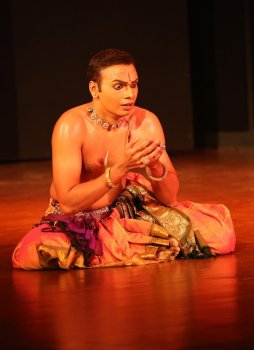 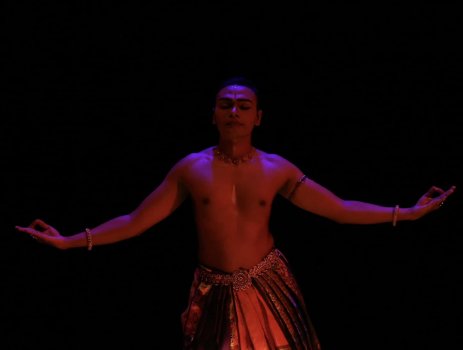 D Dilip (Photos: Ujjal Ganguli) Mythologically, the Kamakshi story emerges as an aftermath to the Manmatha dahanam episode. What Shiva intended to annihilate with this third eye, by a twist of fate, ended with demon Bhandasura rising from the ashes of Manmatha. To put an end to this menace epitomizing the five deadly sins, Devi herself manifests as Kamakshi and destroys the asura. She is wedded to Kameswara, a manifestation of Shiva. The resurrection of Manmatha is from the ashes of Bhandasura. With a take-off point of fine music composed by Srikanth Gopalakrishnan, with his dulcet voice providing the singing, and with Dr.Guru Bharadwaj's mridangam providing rhythmic support with accompanists Sruthi Sagar on flute and Anjani Sreenivasan on veena, and the dance translation revealing clean technique, it all added up to a meticulously worked presentation. Without all these aspects of the performance, the heavy dose of Sanskrit sahitya, like Sumeru madhyashringastha, karanguli nakhotpanna Narayana dashaakrithi; Kamakshi Kamadayini: Kadamba vana vasini; pancha bhramasanashitah and Devi epithets from Lalita Sahasranamam, for a Delhi audience, would have fallen short of being comprehended. The enunciation of the sahitya by Srikanth was flawless and with Dilip's movement interpretation being so expressive, the audience was not entirely clueless. The description of the Goddess with all her iconographic details, her marriage to Shiva, the grief of Rati as husband gets reduced to ashes, the encounter with Bhandasura, finale with a Tarangam finish on the brass plate after the Tillana in Hindolam, had all the ingredients of traditional Kuchipudi incorporated in the recital. While the modest audience showed its appreciation, given the dancer's quiet and serene stage presence, barring an audience familiar with the dance and its imagery, a solo nonstop presentation of an hour and fifteen minutes, of this type, without counter point elements, could have become monochromatic, with the spectator's attention wandering. Which is not to take away from the dancer's credentials but to be aware of the kind of mixed audiences of today with their short attention spans - something to be kept in mind while planning programs. MANTHAN CHURNS 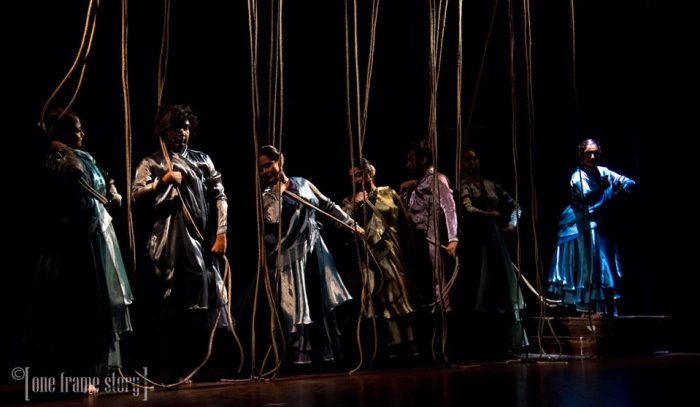 Mirage (Photo: One Frame Story) As a complete antithesis to presentations in the traditional pattern, again at the Habitat, the first day of a two day festival Manthan sponsored by Kalpataru Dance Company run by Kathak dancer Sangita Chatterjee trained under Vaswati Misra, exemplified the kind of mental churning required while using the classical vocabulary for creating work in new directions. During the pandemic isolation forced on artistes, Sangita's virtual presentation of a short film titled A Lust for Life, very well received by viewers outside, provided the inspiration and starting point for a real presentation titled Mirage, fashioned round the idea of life consumed by ideas of a goal never reached - for the faster you seem to be approaching it, the further away it seems to recede. Ultimately life is a chase for that Eldorado, never experienced. Visually, the caged mind, trapped in an endless race towards an imagined paradise (maya ki chal kapat se ulijhhayu, Dor tute to magan tu sulijhau) provided the thrust for Sangita's group work - one of the finest productions seen lately in Kathak. Translating what is virtual into a real production can pose challenges - for the theme chosen is one in which there is no actual finish - invariably symbolized, and presented with such flourish by dancers, in the Kathak 'sam', which stands for the completion of a cycle of time beats. In this concept, the never ending, restless activity of tala never reaches a culmination. It remains a constant frenzy of footprints in time, constantly changing in rhythm and direction the frenetic activity leading nowhere. Paradoxically, dance here has to portray what virtually defies being brought within the traditional contours of a planned cycle of movement. 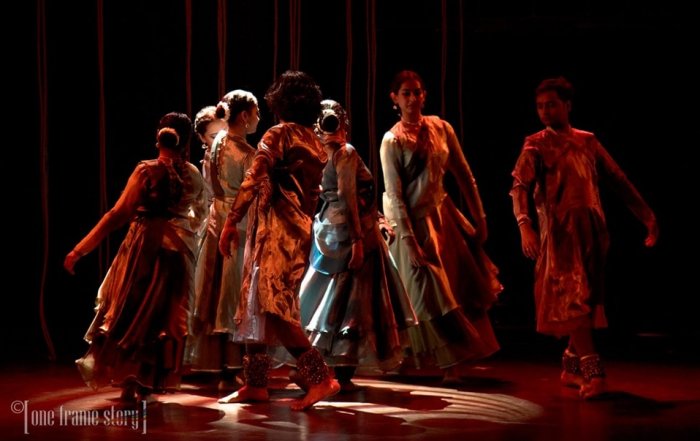 Mirage (Photo: One Frame Story) Drunk on a mental chase for a finish which never materializes (man madd hoker naach magan tu, Dor tute to Sulijhayu) the frenetic mind finally comes to the realization that instead of chasing a mirage, it is inner quietude which should be the goal - maya ki dor tod de manva, rakh paav zami par, udd akash re manva (Discipline your mind, stop flying and anchor yourself with feet on the ground). The dancers' hands playing with the suggestive stage backdrop of hanging ropes, sometimes together in a bunch and at others loose to hang separately, and costume designer Sandhya Raman's idea of costumes as a metaphor for mirage, with the three layered lehenga with salwar underneath in shades of blue, forming layers of circles when the dancers pirouetted, enhancing the symbolism of living in a constantly swirling world of activity while remaining in one place, with Milind Srivastava's sensitive lighting, adding their bits. The sahitya composed by Sangita herself was interpreted in the dance to convey the feel of restless movement, changing in rhythmic accents and direction, creating the indeterminate feel of never reaching a planned destination. Anirban Chatterjee's imaginative music setting in various ragas like Jog, Nand, Chandrakauns, highlighting moods of being seduced by maya, getting intoxicated with repetitive movements portraying a chase with no purpose, with the realization of quietude in the end echoed by the traditional finish of Bhairavi, was just right. Along with Sangita and her own students Kavita Das, Lisa Saha, Sreelata, Arushi Singha and two guest artistes in male dancers Mukesh Kumar Gangani and Rohit Pawar, that feel of racing towards a non-existent goal, was very successfully conveyed. Altogether one must commend this as a very aesthetically conceived performance. 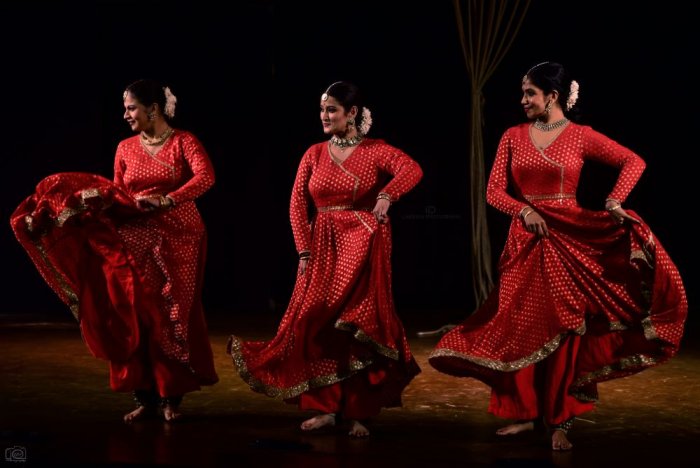 Uma Dogra's disciples The second half of what turned out to be a charmed evening, posted a contrast in approach, with Kathak trying to capture in every way, the flavour and stylistic aura of a bygone Guru, whom death claimed prematurely - viz Durga Lal, the wizard of the Jaipur gharana. Kudos to Uma Dogra, now Chairperson, Advisory Board of the Kathak Kendra, who, one remembers, when the Guru expired, was just one of many of his students - utterly crushed and rendered rudderless by his sudden death. But to have worked so diligently for years on whatever one had imbibed, to reach a stage where one has come to represent the Guru's stylistic khandan, passing on to students a feel for what her Guru provided, is a major achievement. Starting with Shiv Vandana, where homage to awesome Jatadhar Shiva with his bull was portrayed in all the vigor, sans hints at prettiness in the typical Durga Lal style, the nritta in Ashtamangal presented by the three students Sarita Kalele, Vinita Venugopal, and Diksha Rawat for this critic, brought back not just the pure dance magic of the Guru, but more than anything else a feel for the purity of intent in every move, which gave Durga Lal's dance a special conviction. As a dancer, he proved, more than any other artiste I have come across, how the dance reflects the inside of a persona. That Uma Dogra has imparted some of that feel in students who have never seen Durga Lal, speaks strongly for her total allegiance and commitment to her Guru. She recounted, sharing anecdotes, memories with Fateh Singh Gangani who was the percussionist on tabla for Durga Lal and who was seated in the audience, of how when he travelled with Ravi Shankar, during a tour, last minute discussions of a Tarana, set to raga Nand in Ektaal by Asit Desai the singer, was decided upon in the green room for a last minute television program! Remembering what was performed to perfection, but admitting that Durga Lal's phenomenal ability for drut laya, could not be emulated, Uma had taught the item to her students who presented it with refreshing zeal. Such accounts made the evening a kind of reminiscence of the past. 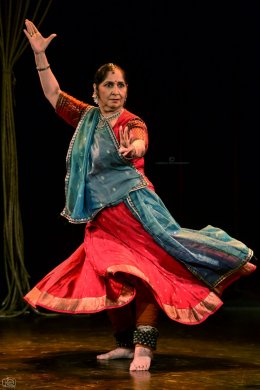 Uma Dogra After all this came pure abhinaya from Uma Dogra, preceded by a totally unwarranted apology to the Kathak audience for veering away from the traditional repertoire by performing abhinaya to a Jayadeva ashtapadi “Keshi mathanam udaram”(the music set by her tablist Vinayak Netke and sung by Manoj Desai). Surely, the language of gestures and movement of a dance tradition is meant to interpret any thought in any language. For instance if one were to limit Bharatanatyam repertoire to only the Padams and Javalis presented in the past, how restricting that would be - by putting out of reach all the breathtaking poetry and ideas from several language sources, which dancers have been inspired by and interpreted in their performances! As for Uma's abhinaya rendition of an Ashtapadi (for which the inspiration, according to her, came from being close to, and watching Odissi Guru Kelucharan Mohapatra in action), the manner in which she has worked on understanding the Ashtapadi, to be able to express it in her medium of Kathak, has to be commended. More so because her Kathak Guru, in his performances, was never known for revealing any abhinaya expertise - though according to his students he had a sensitivity for expressional dance too, which, in the classroom was passed on to his students. Radha, in this Ashtapadi, overcome with desire for Krishna, urgently pleads with the sakhi to fetch 'the killer of Keshi' to her. Her mind goes back to moments of her first intimate encounter with him and the manner in which he had made her overcome her shyness. The involved rendition, while commendable, could, one felt, try to lessen, in the 'prathama samagam' episode an overdose of realistic portrayal in the depiction of Radha's reactions, with more of stylization (not very prevalent in Kathak abhinaya). Radha depicted here as openly showing her urgent desire for Krishna by her side, in her recollections of the first encounter with Krishna, would be different from a totally inexperienced mugdha. 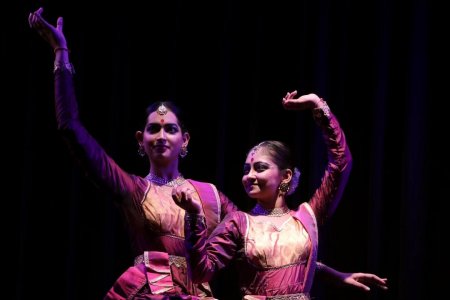  Sangita Chatterjee's students The second evening of Manthan shifted to the Kathak Kendra premises, with students of Sangita performing. With her parhant lead, Sujit Mahant providing vocal support with Rahul Viswakarma on tabla and Atul Shankar on flute, the recital started with homage to Ardhanariswar, the performance by Gita and Arushi based on a composition of late Birju Maharaj. Ganesh Stuti, the Abhinaya Darpana sloka on Rasa creation - by wielding a particular hasta, with the eyes, and mind following, to finally evoke aesthetic relish, Thumri Murali Janedo, taal Dhamar and the usual intra-forms of Kathak nritta were shown by students of all ages - some senior and mostly junior. While refraining from individual critiquing (for which a full-fledged presentation is needed), what one was impressed by was the general sense of discipline, excellently tasteful costuming, a sense of involved joy in the youngsters while dancing, and a general demonstration - amidst dance of different levels of proficiency - of holding the body erect, without back or front bulging, and an awareness of the right stance, and consciousness of how to hold the body. 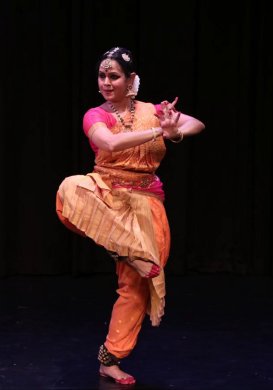 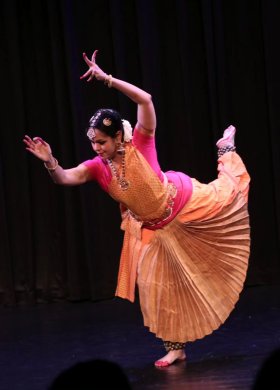 Arupa Lahiry The finale of the Manthan festival was through a performance of Bharatanatyam by Arupa Lahiry. This disciple of Chitra Visweswaran from Chidambaram Academy, having earned the Bismillah Khan Yuva Puraskar, is going places now as Regional Director at IGNCA, earning a name as a thinking dancer. Her entire performance, apart from the quality of the dance, was woven round the idea of how life's highest moments, cannot be objectified - and the ecstatic anandamayam of Sat, chit, Ananda will always remain a 'mirage' - to be realized - existing only in the experience. The performance began with the Mallari, a nritta start evoking nada brahmam or transcendental sound, with the syllables tat dhit tom nom, the lyrics by Venkateshwaran Kuppuswamy and music set to the raga Gambhiranattai. Evocative again of a state-of-being beyond description, the next major presentation in the format of a varnam, musically designed by Sudha Raghuraman, was based on Adi Shankara's verses - Meenakshi Pancharatnam. Sans offering prayers to a representation through an anthropomorphic form, the highest form of Devi worship is embodied in the esoteric geometry of the Sri Chakra (nine interlocking triangles that relate from the Centre, the four upward representing Shiva and the five downward representing Shakti). The Bindu at the centre of the Sri Chakra represents the source of creation and the highest point of consciousness (expressed in the Pancharatnam which extolls Devi as Srichakraangita bindu madhya vasatim). According to Sri Vidya with its esoteric rituals, Shiva/Shakti is non dual, incorporating both the states of Being and of Non-Being. The movements of physical representation in the dance interpreted Devi Meenakshi in the splendour of all her bracelets and garlands as the very embodiment and ocean of compassion (karunya vaaraamnidheem) with Vishnu and Brahma at her lotus feet, worshipped by all the sages (Nanayogimuni). With her place on the left of Shiva (Shivavaamabhaaga nilayaam), the goddess is mother of Ganesha and Kartikeya and one who enjoys music on all instruments (Veena venu mridanga vadhya rasikaa). The abstraction lies in representing her as the innermost essence of everything (nanaarthatvaatmikaam), evoked by the sacred sound (Nada brahmam), and the syllable hreem. Ultimately the dancer has to evoke such a state-of-being, beyond gestures and movement. The tuneful music in the Ragamalika score was designed to bring out each of the attributes of the Devi, and the nritta links in their rhythmic punch emerged as effective counterpoints for the interpretative sections. The modest sized auditorium at Kathak Kendra, with fine acoustics makes performer/audience interaction much easier and taking full advantage of this, Arupa Lahiry in fine form, gave a fitting conclusion to the festival.  Writing on the dance scene for the last forty years, Leela Venkataraman's incisive comments on performances of all dance forms, participation in dance discussions both in India and abroad, and as a regular contributor to Hindu Friday Review, journals like Sruti and Nartanam, makes her voice respected for its balanced critiquing. She is the author of several books like Indian Classical dance: Tradition in Transition, Classical Dance in India and Indian Classical dance: The Renaissance and Beyond. Post your comments Pl provide your name and email id along with your comment. All appropriate comments posted with name and email id in the blog will also be featured in the site. |